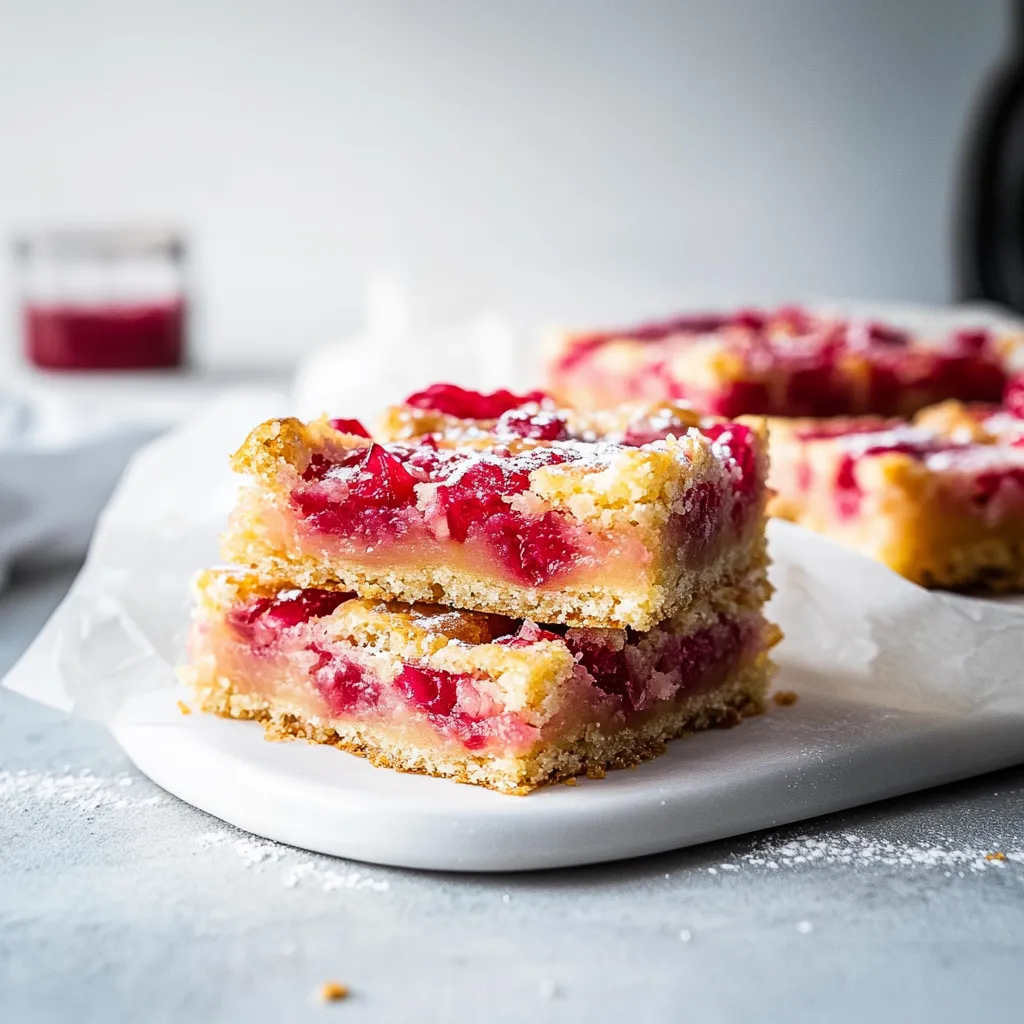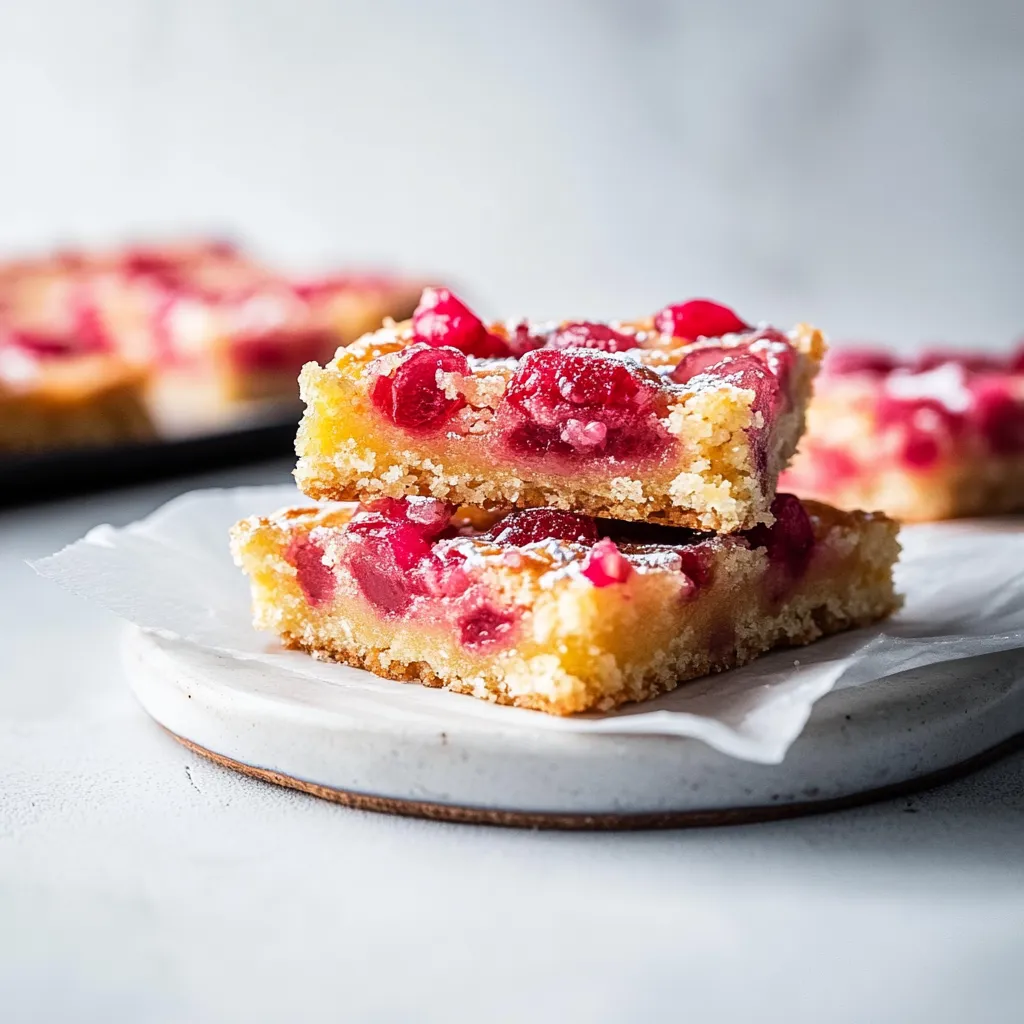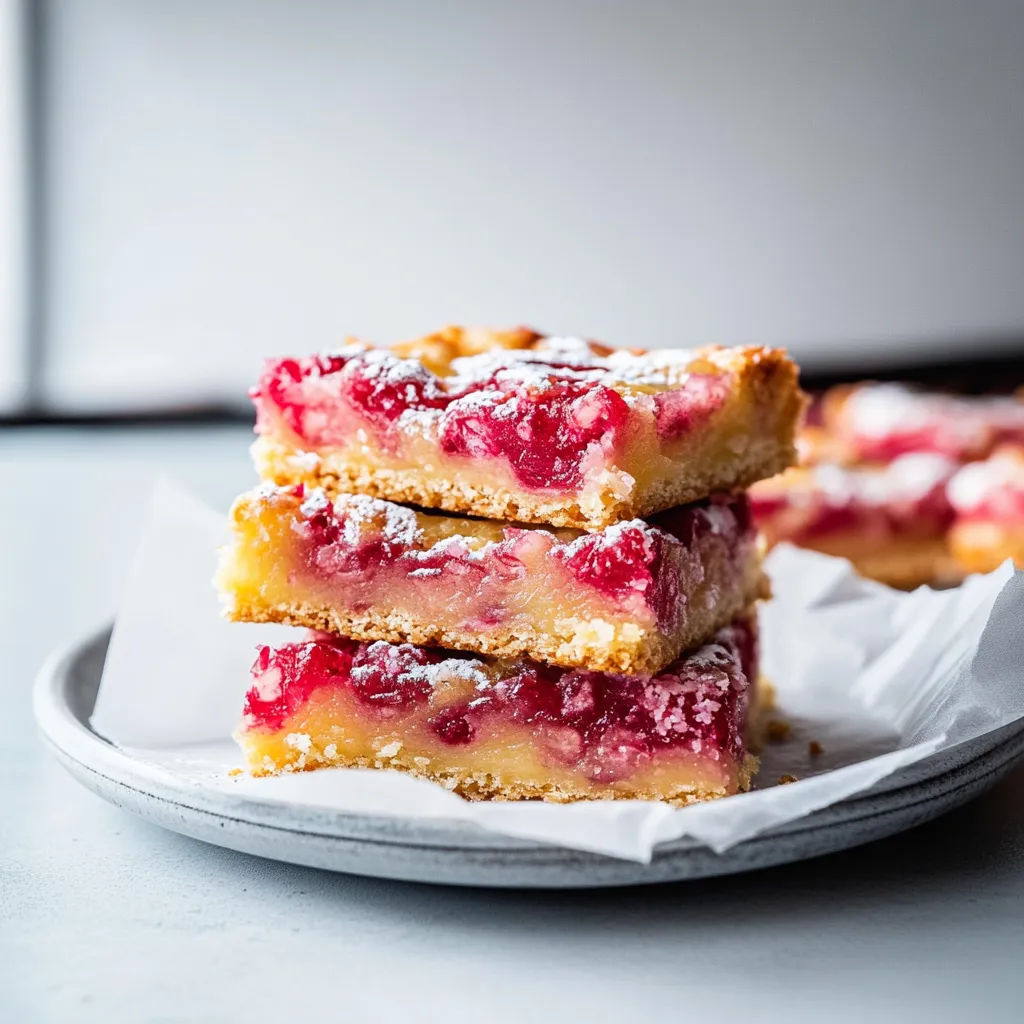 Pin it
Pin it
These bright lemon rhubarb bars bring together the crispness of a buttery shortbread, a sweet-tart custard packed with rhubarb, and a pillowy swirl of toasted Swiss meringue on top. I think they’re the best way to really let the tangy bite of rhubarb shine outside of the usual pies and crumbles—plus, they make any spring swap or summer gathering instantly special.
I first made these when my grandmother gave me a big sack of rhubarb from her garden and I wanted something besides crisp. Now, these bars are my go-to when local rhubarb pops up at the market and I always get a flood of requests after sharing them at book club.
Ingredients
- Unsalted butter: Cold and cubed makes shortbread both crisp and tender so look for intensely yellow butter from local dairies when you can
- Granulated sugar: Adds sweetness to each layer and helps give the shortbread its snap use a fine variety for best dissolving
- All purpose flour: Builds structure in both the crust and custard layers so opt for unbleached if possible for best texture
- Kosher salt: Brightens up the butter flavor I use Diamond Crystal brand and recommend it for its light flake
- Large eggs: Give the custard layer richness and the meringue loft be sure they are very fresh especially for the top
- Heavy whipping cream: Adds body to the custard and a bit of creamy flavor
- Fresh lemon juice: Brings a zippy contrast to the rhubarb try to choose a lemon that feels heavy for its size for maximum juice
- Lemon zest and lemon oil or extract: Deepen the citrus notes which really wakes up the rhubarb
- Rhubarb: Diced for an even bake look for firm stalks with vibrant pink or red color avoid any that feel limp or woody
- Egg whites: Form the backbone of the Swiss meringue for safest results separate eggs when they are cold but let whites warm to room temp before whipping
- Vanilla extract: Adds warmth to the topping I always spoon out from a dark bottle to avoid any off flavors
Step-by-Step Instructions
- Prepare the Pan and Oven:
- Preheat your oven to the right temperature. Set up your square pan with parchment paper so later you can lift out the finished bars easily. Cut one sheet longer than the pan so it makes pullable handles on either side.
- Mix and Press the Shortbread:
- In a stand mixer blend cold butter sugar flour and salt until it has a crumbly texture with visible pieces of butter. Dump the dough into the pan then spread and press it down firmly with your fingers. Use a flat-bottomed glass to smooth it further and help the crust bake up crisp. Chill for half an hour to prevent spreading.
- Bake the Crust:
- Pop the pan into the oven so the shortbread layer bakes until just turning golden with a distinct toasty butter smell. This should take around 10 to 12 minutes. Let the crust cool in the pan on a rack before adding the next layer.
- Make the Custard Base:
- In a mixing bowl whisk flour and sugar together so there are no lumps. Add eggs and blend until smooth then pour in cream lemon juice zest and oil or extract. Stir until all ingredients are completely combined. With a spatula fold in all the diced rhubarb until evenly distributed. Pour onto the cooled crust and tap the pan to remove air bubbles and help the custard settle flat.
- Bake the Custard Layer:
- Put the pan back in the oven and bake until the custard layer is fully set and does not jiggle. Expect 40 to 45 minutes. Cool the pan completely on a rack then chill in the fridge for at least an hour so the bars will hold together when sliced.
- Prepare Swiss Meringue:
- In a small saucepan whisk egg whites sugar and vanilla. Gently heat over low stirring almost constantly until sugar has dissolved and mixture is warm to the touch. If you rub a dab between two fingers it should feel perfectly smooth.
- Whip Meringue to Peaks:
- Transfer the still-warm egg mixture to a clean stand mixer bowl. Whip on high with the whisk attachment until glossy stiff peaks form and the meringue is thick enough to hold sharp swirls about five minutes.
- Finish and Toast Meringue:
- Take the chilled pan out and use the parchment handles to lift bars from the pan. Place on a metal baking sheet. Either spread a thick swoop of meringue evenly on top or slice the bars first and pipe meringue individually on each square for a fancier look. Using a torch toast the meringue until it is gently golden on the edges. Serve soon after topping and keep leftovers in the fridge tightly covered in a single layer.
 Pin it
Pin it
My favorite part is how the soft tart pockets of rhubarb contrast with the bakery-style shortbread crust. When I made them for my nieces one summer, they loved swirling and torching the meringue on top almost as much as eating them.
Storage Tips
Keep any leftover bars refrigerated in a single layer inside an airtight container. This prevents the meringue from turning sticky and keeps the crust crisp. Bars will keep well for up to three days and can be served straight from the fridge.
Ingredient Substitutions
If you do not have access to fresh rhubarb you can use frozen. Thaw and drain well before dicing and folding in. For a dairy free version try swapping coconut cream for the heavy cream and a plant based baking stick for the butter. You could even try lime in place of the lemon for a new twist.
Serving Suggestions
These bars are excellent slightly chilled but close to room temperature for the best flavor. For spring occasions scatter a few edible flowers or curls of lemon zest on top of the toasted meringue. I always like to serve them with softly whipped cream or scatter a handful of fresh strawberries for extra color.
Cultural and Historical Context
Rhubarb has a long history in European and North American baking and was often the first tart treat of spring before berries and stone fruits arrived. Lemon bars are classic in the US and this variation marries old-fashioned rhubarb traditions with a crowd-pleasing meringue topping. It is one of those desserts that feels both familiar and fresh.
 Pin it
Pin it
These bars are your chance to savor the rhubarb season with a simple yet stunning dessert. They'll make any occasion feel a little more special!
Frequently Asked Questions
- → Can frozen rhubarb be used?
Yes, frozen rhubarb works well. Thaw and drain excess moisture before folding into the custard layer.
- → How do I achieve firm, clean slices?
Chill bars completely in the fridge before slicing. Wipe the knife blade clean between each cut for neat edges.
- → Can I make the crust ahead of time?
Absolutely. The shortbread crust can be baked a day ahead and kept covered at room temperature until layering.
- → Is a kitchen torch necessary for the meringue?
While a torch gives a toasted finish, bars can be enjoyed without toasting or the topping can be lightly baked under the broiler.
- → How should these bars be stored?
Keep bars refrigerated in a single layer inside an airtight container. Consume within 2-3 days for the freshest texture.
- → What is the benefit of Swiss meringue?
Swiss meringue is stable and glossy, offering a silky, marshmallow-like texture that complements the fruity custard and buttery crust.
